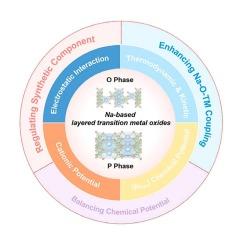Phase transition and targeted modulation mechanisms of layered cathodes for sodium-ion batteries
IF 22
1区 材料科学
Q1 MATERIALS SCIENCE, MULTIDISCIPLINARY
引用次数: 0
Abstract
Na-based layered transition metal oxides (NaxTMO2) are considered as the promising cathodes for high-performance sodium-ion batteries (SIBs) because of the scalable synthesis and high theoretical capacity. Most attention thus far has been focused on activating anionic redox and addressing irreversible lattice oxygen loss to enhance the energy density of NaxTMO2. However, the poor cycling stability of NaxTMO2 remains a tough problem in commercial application, and the essential phase transition mechanism closely related to the cycling stability is also still being investigated and puzzling. Herein, we provide a thorough and comprehensive overview on the phase transition mechanisms from the perspectives of chemical potential, thermodynamic, kinetic and electrochemical driving force. Notably, the connection between the different driving force is then identified, which is the crux of clarifying phase transition mechanism. Moreover, the corresponding regulation strategies is also presented to guide the construction of high-performance NaxTMO2 cathodes. Finally, the future prospects and the challenges are proposed to navigate the practical application of SIBs.

钠离子电池层状阴极的相变和定向调制机制
钠基层状过渡金属氧化物(NaxTMO2)由于其可扩展的合成和较高的理论容量,被认为是高性能钠离子电池(sib)极具前景的阴极材料。目前,人们主要关注的是通过激活阴离子氧化还原和解决不可逆晶格氧损失来提高NaxTMO2的能量密度。然而,NaxTMO2循环稳定性差仍然是商业应用中的难题,与循环稳定性密切相关的本质相变机制也仍在研究和困惑中。本文从化学势、热力学、动力学和电化学驱动力等方面对相变机理进行了全面的综述。值得注意的是,由此确定了不同驱动力之间的联系,这是阐明相变机理的关键。并提出了相应的调控策略,指导高性能NaxTMO2阴极的构建。最后,提出了未来的展望和面临的挑战,以指导sib的实际应用。
本文章由计算机程序翻译,如有差异,请以英文原文为准。
求助全文
约1分钟内获得全文
求助全文
来源期刊

Materials Today
工程技术-材料科学:综合
CiteScore
36.30
自引率
1.20%
发文量
237
审稿时长
23 days
期刊介绍:
Materials Today is the leading journal in the Materials Today family, focusing on the latest and most impactful work in the materials science community. With a reputation for excellence in news and reviews, the journal has now expanded its coverage to include original research and aims to be at the forefront of the field.
We welcome comprehensive articles, short communications, and review articles from established leaders in the rapidly evolving fields of materials science and related disciplines. We strive to provide authors with rigorous peer review, fast publication, and maximum exposure for their work. While we only accept the most significant manuscripts, our speedy evaluation process ensures that there are no unnecessary publication delays.
 求助内容:
求助内容: 应助结果提醒方式:
应助结果提醒方式:


